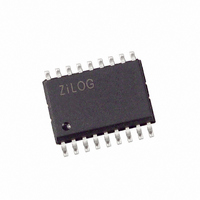Z8622912SSC Zilog, Z8622912SSC Datasheet - Page 16

Z8622912SSC
Manufacturer Part Number
Z8622912SSC
Description
IC CCD W/2ND I2C ADD 18-SOIC
Manufacturer
Zilog
Type
Video Decoderr
Datasheet
1.Z8622912PSC.pdf
(52 pages)
Specifications of Z8622912SSC
Applications
Set-Top Boxes, TV
Voltage - Supply, Digital
4.75 V ~ 5.25 V
Mounting Type
Surface Mount
Package / Case
18-SOIC (7.5mm Width)
Processor Series
Z8622x
Core
Z80
Data Bus Width
8 bit
Program Memory Size
3.7 B
Maximum Clock Frequency
12 MHz
Number Of Programmable I/os
18
Operating Supply Voltage
4.75 V to 5.25 V
Maximum Operating Temperature
+ 70 C
Mounting Style
SMD/SMT
Minimum Operating Temperature
0 C
Lead Free Status / RoHS Status
Contains lead / RoHS non-compliant
Voltage - Supply, Analog
-
Lead Free Status / Rohs Status
No RoHS Version Available
Available stocks
Company
Part Number
Manufacturer
Quantity
Price
Part Number:
Z8622912SSC
Manufacturer:
ZILOG
Quantity:
20 000
< ( 7 0 % 6 + 1 0 # . & ' 5 % 4 + 2 6 + 1 0
Text Mode Display
When the Text mode is selected, a black box is displayed
as long as a valid Line 21 code in the specified field is being
detected. The Z86229 provides the option to make the box
blue instead of black. This option holds for captions and
text.
The default Text display mode uses a 15 row by 34 character
black box. Text characters are displayed as they are received
starting at the top row. Successive carriage returns move the
display down successive rows until all 15 rows have been
displayed. Thereafter, the text scrolls up as new characters
are added to the bottom row.
If the data for the selected channel is interrupted by a com-
mand for another channel, data processing stops; however,
the display remains. When a Resume Text command is re-
ceived, data processing resumes and the new characters are
added.
Note:
If a Start Text command is received, the display is cleared,
and the new characters are displayed starting in row 1, col-
umn 1 (left side).
The number of display rows and the location (base row) of
the Text box can be altered by the user. In this way, the user
can decide how much of the screen can be covered when
displaying non-program related information.
When scrolling, the display shifts one scan line per frame
until a complete row has been scrolled. If a carriage return
is received before scrolling is complete, the display imme-
diately completes the “scroll” by jumping up the remaining
scan lines and starting the display of the new text.
Caption Display Mode
According to FCC specifications, caption data can appear
in any of the 15 display rows, but a single caption may con-
sist of no more than 4 rows. The form of the caption display
depends on the caption mode indicated by the transmitted
caption command, Pop-on, Paint-on, or Roll-up. The
Z86229 can display a single caption having as many as eight
rows. When any of the caption display modes are selected,
the screen becomes transparent
Note:
The data processing begins at the position that the display
Display box is only present when a caption is being dis-
row/column pointer was in at the interruption of data pro-
cessing.
played.
% Q P V K P W G F
Pop-on captions work with two caption memories. One of
them is normally displayed while the other is being used to
accumulate new caption data. A new caption is popped-on
by swapping the two memories with the End Of Caption
(EOC) command. When the on-screen memory is erased,
the screen is blank (transparent), and the memory defaults
to the row/column pointer at row 1, column 1, and mono-
chrome are non-underlined.
When caption mode is selected, the decoder processes data
following the Resume Caption Loading (RCL) command
(or the EOC). Normally, this command is followed by a Pre-
amble Address Code (PAC) to indicate the row, column,
and character attributes to be used with the following data.
If no PAC is received, the data is added to the location most
recently indicated by the row/column pointer prior to the
receipt of the RCL command.
The Paint-on caption mode is essentially equivalent to the
Pop-on mode; however, the data received after the Resume
Direct Captioning (RDC) command is written to the on-
screen memory rather than the off-screen memory. All the
rules for PACs, Midcodes, and so on, are otherwise the
same.
The Roll-up caption mode presents a “text” like display that
is limited to 2, 3, or 4 rows, depending on the Resume Roll-
up (RUn) command used. The PAC following the RUn
command is used as the BASE ROW for the ROLL-UP dis-
play. The BASE ROW is the “bottom” row of the ROLL-
UP display. In this case, the black box does not appear until
characters are being displayed, and the Box is only wide
enough to provide a leading and trailing box in each line.
The new data appears in the bottom row, and as each car-
riage return is received, the row scrolls up and the new data
is added to the bottom. When the number of rows indicated
by the Resume command have been reached, the data in the
top row scrolls off as new data is added to the bottom.
The TAB (INDENT) PAC permits placing captions starting
at 4 character boundaries in any caption row. The TAB
OFFSET command provides the means for adjusting the
starting position for a caption at any column position in the
current row.
XDS Display Modes
Two preprogrammed XDS display modes are provided.
One provides information about the current program that
would be of interest for “channel grazing”. The second dis-
play shows the grazing packets, plus additional XDS pack-
ets which informs the viewer about the program content. In-
formation is displayed as it is received. The displays use a
drop-shadow mode with 15 scan lines per row.
ZiLOG


















